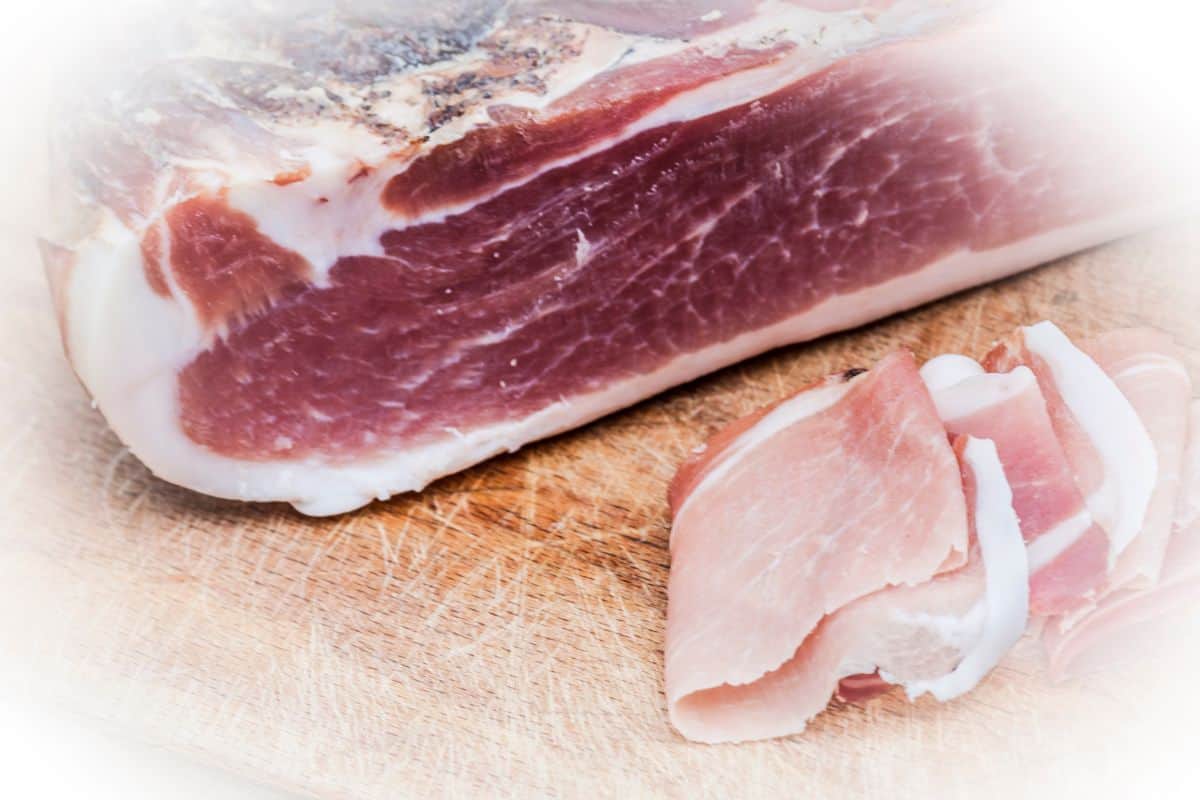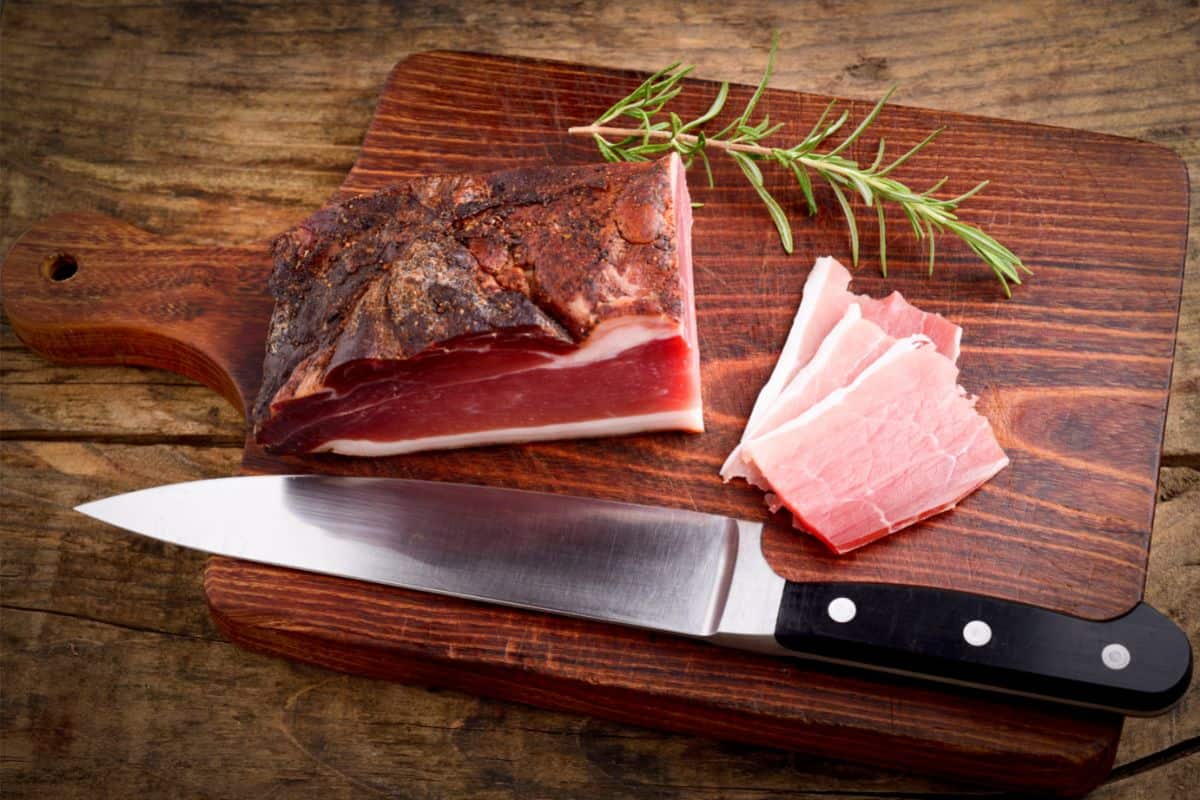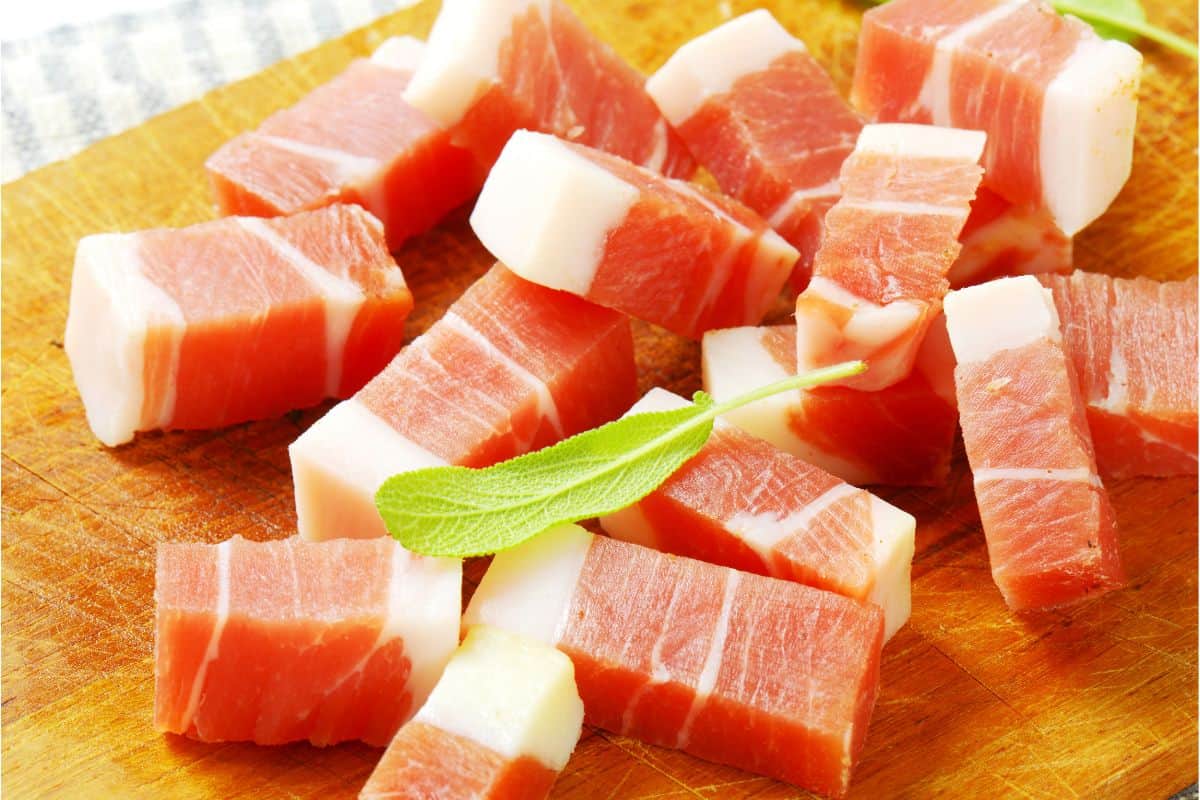From Which Animal Part Does Speck Come From?
You may be asking yourself, what is speck food and from which animal part does it come? Speck is pork fat usually cut in slabs or fat from cured or smoked pork. Speck comes from pork, but, in this case, you use the thigh after you completely debone, open up, and flatten it. Read on to the end of this article to understand more about speck.

What is Speck (Food)?
Speck is sort of carefully smoked, cured ham. Its production is most common in South Tyrol, a northeastern Italian province. This province is popular for its snow-capped dolomite mountains and strong German-Austrian influence. Speck has a very close relation to prosciutto crudo, yet it deserves its own identity when it comes to cured hams.
Speck is Südtirol’s most prized food product. It is a flavored, smoked, and cured ham. Speck epitomizes the alto adige cuisine’s exquisite and nuanced fusion of northern European and Mediterranean traditions.
Speck has a milder flavor than the Italian smoked hams found north of the Alps. It’s still more robust than the delicate, Mediterranean-influenced prosciutto found in San Daniele, Parma, and other southern cities.
Speck is meat comparable to bacon, prosciutto, and pancetta. However, it has a distinct flavor, and you prepare it differently. You can serve speck as an appetizer on a charcuterie board in Italian and Tyrolean cuisines.
You can also use it in cooked dishes. Speck enjoys a protected designation of origin (PDO) in the European Union. This is according to Wisegeek. It implies that only meat produced in a certain area of Tyrol and according to traditional procedures may have the ‘speck’ label.
Speck vs. Prosciutto – The Difference
Speck
Even the tiniest piece of this rich, reddish ham packs a punch of flavor. You debone and rub down with a cure that includes spices like juniper and bay leaves. After that, you smoke and age it. Thanks to the seasoned curing, Speck has a richer flavor than prosciutto di parma. For the record, it’s also delicious with roasted sweet potatoes.
Prosciutto Di Parma
Most likely, you’ve already met prosciutto di parma. This Italian delicacy is best cut into paper-thin and eaten on its own after curing it with salt and aged between one and two years. The flesh becomes drier, darker, and more flavorful as it ages. The flavor and complexity of the 24-month prosciutto will be greater than that of the 12-month prosciutto.
Prosciutto Cotto
Prosciutto Cotto means “cooked”. It is the European version of the deli ham you remember from lunches while growing up.
Here are some of the notable differences that you will come across between speck and prosciutto:
Speck, unlike prosciutto, you smoke it before aging it. Speck is sometimes known as “smoked prosciutto.” Although the cooking process is the most significant difference, it would be incorrect to claim that it is the only difference.
The blend of spices used to make speck is one difference worth highlighting. You usually add bay leaves and juniper berries to speck, but this is not the case with prosciutto.
Truthfully, you salt and pepper most forms of prosciutto, but for speck, you will usually spice it. The spice blend varies with each maker.
It’s often a family secret passed down only to those who continue the production. This unique spice blend enhances the flavor of speck. Due to a slight modification in the cooking technique, Speck has a deeper, smoky flavor and a darker hue.
Speck also has a denser and more elastic texture. Finally, speck is often thinner than prosciutto, with less fat and more meat per pound.

How is Speck Made?
First, we refer to legitimate speck as speck alto adige. Because a governing consortium must scrutinize each ham, this mark ensures the product’s authenticity and quality. Twenty-nine recognized producers now produce speck alto adige.
Choosing high-quality raw materials is the first step in making speck. You only select the best pork legs, which you source from pigs that feed on a particular diet and are grown in a specific manner. How to transport the speck meat to the processing facility follows strict standards. This includes the requirement that you do not freeze it whatsoever.
The second step is to rub each hog leg with a spice blend that often includes salt, pepper, juniper berries, and bay leaves. Although you use salt and pepper, each producer’s spice mix recipe varies. Each pork thigh must include more than five percent salt to achieve the consortium’s guidelines.
Thirdly, the pork thighs are then left to marinade in their spice rubs for up to three weeks in cool rooms. You flip the legs numerous times to ensure uniform distribution of the spices throughout the flesh. The smoking procedure is one of the most important factors in speck’s distinct flavor.
You usually do this outside, using a unique approach that includes a little smoke and a lot of fresh mountain air. The temperature in the smoker must not surpass 68 degrees Fahrenheit (20 degrees celsius); if it does, the smoke will not manage to penetrate through the meat!
Over several months, you do the smoking gradually, for a few hours at a time. According to the hypothesis, a slow, delicate procedure allows the smoke to permeate the flesh. In contrast, a faster, more powerful process only concentrates the outer layer.
It’s taken to the curing cellar after smoking. Mature the hams in calm, well-ventilated rooms for around 22 weeks. The spice rub coating acts as a protective mold, keeping the speck moist and helping it to cure evenly on the inside.
Speck, like prosciutto, is a dry-cured ham, but the two differ. Gently smoke the hams using low-resin wood at a carefully controlled low temperature to make specks. After three weeks of dry curing, ensures that the speck cured meat remains sweet and has a mildly smokey flavor to complement the particular seasoning.
Another important aspect of speck’s flavor characteristic is the fresh Alpine air. For nearly six months, the meat is vent in rooms that allow the South Tyrol climate to flow around it. This allows the formation of a thin coating of whitish mold that mellows and balances the flavor. Finally, the consortium inspects it before packaging each pork thigh and delivering it to market!
What Does Speck Taste Like?
A little salt, little smoke, and plenty of fresh mountain air all sum up speck’s secret in a single statement. Unlike its prosciutto crudo relative, speck is browner in color and denser. It’s well-marbled, with a soft, supple texture and a rich flavor. It has a savory, smoky flavor with juniper, bay leaf, and other spices. Its aromas are reminiscent of the mountains on the nose.
Speck Serving Suggestions
Speck is wonderful as a savory snack or antipasto on its own. You could also build a meat and cheese board with speck slices and Piave DOP cheese. This has delicate fruit notes that match the smokiness of the speck.
You can use speck in a variety of meals in the kitchen. You can use it to make canederli. These are bread dumplings distinctive of the Trentino Alto-Adige area for an authentic South Tyrolean feast. It’s also delicious with red radicchio, eggs, and pasta. Read our article and find out how to store fresh pasta.
In the Südtirol, speck, bread, and wine constitute a trio that is the most basic of meals. A local cheese, pickles, and a little fruit are a requirement to complete the meal.
This simple method of consuming speck is encouraged. Thinly sliced and presented on a dish, then eaten by hand with pristine accompaniments and a bottle of Lagrein. This allows the flavor to shine through.
Aside from that, shaved speck is simple to add to your cooking. We use it in various traditional Südtirol recipes. You can experiment with it in the same way you would with prosciutto. A delicious sauce for pasta or fresh asparagus combines with crumbled specks crisped in a pan with a little milk and fresh herbs.
You can make a Tyrolean salad by scattering arugula, sliced boiled potatoes, thinly sliced fresh radishes, chopped hard-boiled egg, and curly Grana Padano shavings over a tray. Also include sliced speck and dressing it all with olive oil. Make a frittata with speck, sautéed shallots, wild mushrooms, and Asiago.
So, whichever your preference is, you will find something sweet for you to serve your speck with.

Parting Words
Ham is nothing new to us, from second-grade lunches to easter dinners at grandma’s house. But saying every ham is the same is like saying all beef is steak. It’s just not true. While all hams come from pigs’ legs, how you will cure, season and smoke or not will make a massive difference in the final product.
You can find the speck ham in most Italian pork stores and salumerie—make sure it is the authentic speck. We are quite aware that at this point, you have all the information and are in a better position to differentiate speck from other hams. Next time you place an order or serve a meal, include a speck on the list or menu. Buon appetito!!

Community of passionate writers and content creators who share a love for Italian heritage, culture, travel, food, and the Italian-American community. Our mission is to celebrate Italy’s rich history and traditions and connect with others who share the same passion.

